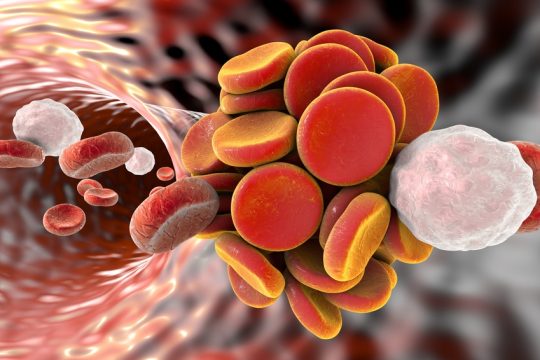The WOEST study found a significant reduction in bleeding complications post PCI with oral anticoagulation indication (OAC) when treating patients with dual antiplatelet therapy (DAPT) vs. the triple antithrombotic scheme. Several randomized studies have shown these results. At present, the guidelines recommend using the triple antithrombotic scheme in patients according to ischemic and bleeding risk. …
RESTORE | Using Rivaroxaban to Prevent Radial Artery Occlusion After an Intervention
Radial access has long demonstrated its benefit, but one of its most feared complications is radial artery occlusion (RAO), which can vary from 1% to 5% according to different series. There is currently no significant information on post-procedural anticoagulation and the presence of RAO at follow-up. The aim of the randomized RESTORE study was to…
Left Atrial Appendage Closure vs Direct Anticoagulants at Long Term
The PRAGUE-17 has shown that left atrial appendage closure is not inferior to direct anticoagulants at long term to prevent major cardiovascular, neurological, or bleeding events. Moreover, procedures not related to prosthesis implantation saw significant reduction. The PRAGUE-17 was a randomized non-inferiority study comparing left atrial appendage closure (Watchman or Amulet) with direct anticoagulants (95%…
PRAGUE-17: Appendage Closure vs. Direct Anticoagulant Agents
After four years of follow-up, the PRAGUE-17 study showed that appendage closure is non-inferior to direct anticoagulant agents (non-warfarin oral anticoagulants, NOAC) to prevent major neurological events, cardiovascular events, and bleeding events in patients at high risk of atrial fibrillation. Appendage studies were compared with warfarin studies—it was necessary to update anticoagulant agents and reach…
AFIRE Study | Hidden Risks After Bleeding in Coronary Disease and Atrial Fibrillation
Patients with atrial fibrillation (AF) and stable coronary disease who suffer from major bleeding present an extremely high risk of subsequent cardiovascular events. Preventing bleeding is necessary, and so is preventing the risk of subsequent cardiovascular events and death. The association between coronary angioplasty, early bleeding, and an increase in death and infarction rates after…
Atrial Fibrillation and Dementia: Which Anticoagulant Agent Presents the Lowest Risk?
Atrial fibrillation is a risk factor for dementia and anticoagulant agents have been proven to decrease it. This work aims to find differences in the risk of dementia between patients treated with traditional choice warfarin vs. different direct anticoagulants. Between 2014 and 2017, this study enrolled 72,846 patients >40 years with nonvalvular atrial fibrillation who…
AFIRE Trial: Atrial Fibrillation and PCI. What is the Ideal Therapy?
Patients with atrial fibrillation undergoing percutaneous coronary intervention (PCI) will benefit from rivaroxaban monotherapy both in terms of safety and efficacy. The AFIRE study included 2215 patients with atrial fibrillation and stable coronary artery disease (CAD). A subgroups analysis recently published in JACC Intv evaluated patients undergoing coronary stenting. The study compared rivaroxaban + antiplatelet…
Are Antithrombotics Necessary in Outpatients after COVID-19?
According to this recent study (soon to be published in JAMA), antithrombotic therapy has no clinical benefits for outpatients with stable symptoms of COVID-19. Both aspirin and apixaban in therapeutic or prophylactic doses did not reduce major cardiovascular events compared against placebo, though these events are rare, which makes it difficult to show any benefit. …
TAVR and Anticoagulation: Direct Anticoagulant Agents or Vitamin K Inhibitors?
In some patients, using an anticoagulant agent is not an option, it is just prescribed. Based on the French TAVR registry, this research compared long-term mortality, bleeding, and ischemic events after valve implantation. A comparison was made between TAVR and direct vs. classic anticoagulant agents—good old proven and reversible vitamin K inhibitors. Cardiologists, hematologists, clinicians, and…
European Consensus on Antithrombotic Management in TAVR
All the controlled randomized evidence recently published called for an updated document on antithrombotic management in transcatheter aortic valve replacement (TAVR). While thrombotic and hemorrhagic complications have diminished over time—as both the technique and the devices have been perfected—, they still remain as common adverse events in TAVR. Recommendations in the 2017 European Guidelines were…
ACC 2021 | VOYAGER PAD: Usefulness of Rivaroxaban After Peripheral Angioplasty
Patients with peripheral vascular disease who undergo angioplasty in the lower limbs find benefit from treatment with rivaroxaban, according to the VOYAGER PAD study, presented at the scientific sessions of the American College of Cardiology (ACC) 2021 Congress and simultaneously published in JACC. Patients with said disease present a higher risk of ischemic events not…










